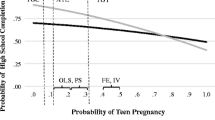Abstract
Numerous studies of fertility behavior find that an early age at first birth increases the rate of subsequent childbearing. Typically, however, these studies do not account for the possibility of serial correlation in the unobserved determinants of fertility. Using 1979–1992 individual-level data from the National Longitudinal Survey of Youth, this paper employs the Method of Simulated Moments to estimate panel probit models of annual birth outcomes. The panel probit models account for several alternative sources of serial correlation. Estimation reveals that once serial correlation is taken into account, the subsequent fertility effects of early childbearing are either statistically eliminated or reversed.
Similar content being viewed by others
References
Blackburn ML, Bloom DE, Neumark D (1993) Fertility timing, wages, and human capital. Journal of Population Economics 6:1–30
Bronars S, Grogger J (1994) The economic consequences of teenage childbearing: Results from a natural experiment. American Economic Review 84:1141–1156
Butler JS, Moffitt RA (1982) A computationally efficient quadrature procedure for the one-factor multinomial probit model. Econometrica 50:761–764
Center for Human Resource Research (1992) NLS Handbook 1992. Columbus, OH: Ohio State University
Geronimus A, Korenman S (1992) The socioeconomic consequences of teenage childbearing reconsidered. Quarterly Journal of Economics 107:1187–1214
Geweke J, Keane MP, Runkle D (1994) Alternative computational approaches to inference in the multinomial probit model. Review of Economics and Statistics, 76:609–632
Hajivassiliou V, McFadden D, Ruud PA (1994) Simulation of multivariate normal rectangle probabilities and their derivatives: Theoretical and computational results. Mimeo, Yale University
Happel SK, Hill JK, Low SA (1984) An economic analysis of the timing of childbirth. Population Studies 38:299–311
Heckman JJ, Hotz VJ, Walker JR (1985) The influence of early fertility on subsequent births and the importance of controlling for unobserved heterogeneity. Bulletin of the International Statistical Institute 51:14.4.1–15
Heckman JJ, Walker JR (1991) Economic models of fertility dynamics: A study of Swedish fertility. In: Schultz TP (ed) Research in Population Economics, Vol 7. Greenwich, CT: JAI Press
Hofferth SL (1987) The social and economic consequences of teenage childbearing. In: Hayes C, Hofferth S (eds) Risking the Future: Adolescent Sexuality, Pregnancy, and Childbearing, Vol II. Washington DC, National Academy Press
Hoffman SD, Foster EM, Furstenberg FF Jr (1993) Re-evaluating the costs of teenage childbearing. Demography 30:1–14
Hotz VJ, McElroy SW, Sanders SG (1995) The costs and consequences of teenage childbearing for mothers. Mimeo, University of Chicago
Hotz VJ, Miller RA (1988) An empirical analysis of life cycle fertility and female labor supply. Econometrica 56:91–118
Keane MP (1992) Simulation estimation for panel data models with limited dependent variables. In: Maddala GS, Rao CR, Vinod HD (eds) Handbook of Statistics, Vol 11. Amsterdam, Elsevier Science Publishers
Keane MP (1994) A computationally practical simulation estimator for panel data. Econometrica 62:95–116
Klepinger D, Lundberg S, Plotnick R (1995a) Adolescent fertility and the educational attainment of young women. Family Planning Perspectives 27:23–28
Klepinger D, Lundberg S, Plotnick R (1995b) How does adolescent fertility affect the human capital and wages of young women? Paper presented at the Population Association of America Meetings in San Francisco, CA
Matthews S, Ribar DC, Wilhelm MO (1995) The effects of economic conditions and access to reproductive health services on state abortion and birth rates. Mimeo, Pennsylvania State University
McFadden D (1989) A method of simulated moments for estimation of discrete response probabilities without numerical integration. Econometrica 57:995–1026
Merz JF (1994) A review of abortion policy: Legality, Medicaid funding, and parent involvement, 1967–1994. Mimeo, Rand Corporation
Moffitt RA (1984a) Optimal life-cycle profiles or fertility and labor supply. In: Schultz TP, Wolpin KI (eds) Research in Population Economics, Vol 5. Greenwich, CT, JAI Press
Moffitt RA (1984b) The estimation of fertility equations on panel data. Journal of Human Resources 19:22–34
Montgomery M, Trussell J (1986) Models of marital status and childbearing. In: Ashenfelter O, Layard R (eds) Handbook of Labor Economics. Amsterdam, North-Holland
Olsen R, Farkas G (1989) Endogenous covariates in duration models and the effect of adolescent childbirth on schooling. Journal of Human Resources 24:37–53
Ribar DC (1994) Teenage fertility and high school completion. Review of Economics and Statistics 76:413–424
Ribar DC (1995) The socioeconomic consequences of young women’s childbearing: Reconciling disparate evidence. Mimeo, Pennsylvania State University
US Bureau of Economic Analysis (1992) Regional Economic Information System. Washington, DC, US Department of Commerce
US Bureau of Health Professions (1993) Area Resource File. Springfield VA, National Technical Information Service
Upchurch D, McCarthy J (1990) The timing of a first birth and high school completion. American Sociological Review 55:224–234
Vijverberg WPM (1984) Discrete choices in a continuous time model: Life-cycle time allocation and fertility decisions. In: Schultz TP, Wolpin KI (eds) Research in Population Economics, Vol 5. Greenwich, CT, JAI Press
Author information
Authors and Affiliations
Rights and permissions
About this article
Cite this article
Ribar, D.C. The effects of teenage fertility on young adult childbearing. J Popul Econ 9, 197–218 (1996). https://doi.org/10.1007/s001480050014
Received:
Accepted:
Issue Date:
DOI: https://doi.org/10.1007/s001480050014




